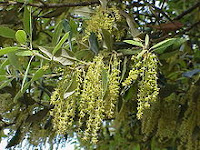The Holly or Holm oak (Holm is an old word for holly) is a native of southern Europe and Greece Italy Ireland British Isles , but there it has become naturalized. It can also be found in forests on the Atlas Mountains in Morocco
It actually looks similar to the English or Common oak tree, Quercus robur, although the acorns are more elongated and pointed than those of the tree that is native to Britain
The ancient Greeks revered the oak tree and this may have been the one they had at Dodona Miletus
In Roman mythology, Jupiter is supposed to have found shelter under a Holm oak when he was an infant.
In ancient Greece
Like other oaks, the bark has astringent properties and so decoctions can be given for diarrhoea and dysentery. However it is the galls, the vacant larvae of insects that are used in medicine for their astringency. They are used to treat chronic diarrhoea, haemorrhages and dysentery.
In Portugal Spain
 While the Greeks used the oak for foretelling the future, the Romans were more practical and used the wood for agricultural implements as well as cart and carriage wheels.
While the Greeks used the oak for foretelling the future, the Romans were more practical and used the wood for agricultural implements as well as cart and carriage wheels. The trees are slow-growing but reach great heights, of up to 82 feet on average with a spread of 68 feet. They are mighty oaks just like the rest of their family.





















